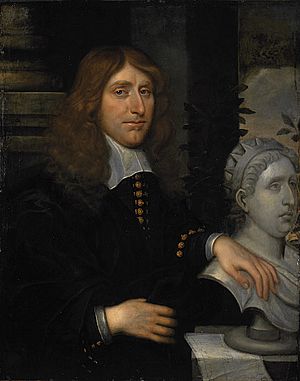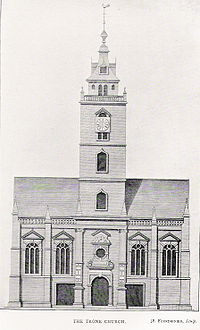John Mylne (died 1667) facts for kids
Quick facts for kids
John Mylne
|
|
|---|---|

John Mylne, painted by an unknown artist around 1650
|
|
| Born | 1611 Perth, Scotland
|
| Died | 24 December 1667 (aged 55–56) Edinburgh, Scotland
|
| Occupation | Architect |
| Buildings | Tron Kirk, Edinburgh Cowane's Hospital, Stirling Panmure House, Angus |
John Mylne (born 1611 – died 24 December 1667) was a very important Scottish builder and architect. He was known as a "master mason," which means he was a skilled stoneworker and builder. He even became the main builder for the King of Scotland!
John Mylne was born in Perth. His father, also named John Mylne, was a master mason too. So, John learned his building skills from his dad. He didn't just build things; he also designed them. He was one of the last great architects of the Scottish Renaissance style, which was a popular building style in Scotland at the time. Besides his building work, he was also a soldier and a politician.
Building a Career
John Mylne learned his trade by helping his father. One of their projects was building a sundial at Holyrood Palace. In 1633, John became a "burgess" of Edinburgh. This meant he was an official citizen of the city. He also joined the Edinburgh group of masons, which was like a club for skilled builders. He got these positions because of his father's good standing.
In 1636, John Mylne joined the Edinburgh town council, helping to make decisions for the city. In the same year, he became the main builder for the King, taking over from his father.
Most of John Mylne's building projects were in Edinburgh. From 1637, he was the main master mason for the city. For ten years, he worked on building the Tron Kirk on the High Street. This church opened in 1647.
The Tron Kirk was built for a new way of worship. It had a "T-plan" shape, with the pulpit (where the preacher stands) in the middle. This design was inspired by Dutch architecture, especially the church designs of Hendrick de Keyser. John Mylne worked with John Scott, who was in charge of the wood parts. The church mixed older "gothic" styles with newer "classical" details. The church wasn't fully finished before Mylne died, and it was changed later. But you can still see Mylne's work in the main part of the church. His brother, Alexander, carved the beautiful stone panel above the door.
From 1637 to 1649, Mylne also designed Cowane's Hospital in Stirling. This building was constructed by another mason named James Rynd. Mylne even carved a statue of the hospital's founder for the front of the building. In 1642, Mylne checked the old ruins of Jedburgh Abbey. For this work, he became a burgess of Jedburgh. He also built parts of Airth Old Church, starting in 1647.
From 1643 to 1659, he was the master mason for Heriot's Hospital (which is now a school). This building had been started in 1628. Mylne rebuilt some of its towers in 1648. Also in 1648, Mylne was asked to fix the crown-shaped spire of St Giles' Cathedral in Edinburgh.
In the 1650s, Mylne worked on building forts in Leith. He also added places for cannons to Edinburgh's city wall. He divided Greyfriars Kirk so two groups could use it. He also built a house for a professor at Edinburgh University, but this house was taken down later.
After King Charles II returned to the throne, Mylne was confirmed again as the Royal Master Mason. In 1663, he was asked to check the upper floors of Holyrood Palace. His plans for the palace are the oldest surviving architectural drawings from Scotland. They are kept in the Bodleian Library in Oxford. His design for the palace was not built, and another architect, Sir William Bruce, finished the work later.
In 1666, John Mylne designed and started building Panmure House, near Forfar. This house was for the Earl of Panmure. After Mylne died, other builders finished the work. This house looked like older Scottish buildings, not the newer styles that were coming into fashion. During a war with the Dutch (1665–1667), Mylne designed and built forts at Lerwick. These forts were later rebuilt as Fort Charlotte. In 1667, he designed a "tolbooth" (a town hall and jail) for Linlithgow. But he died before it was built, and a different design was used. He also worked on plans for Leslie House.
Mylne's buildings are in the Scottish Renaissance style. This style mixed older gothic elements with classical parts, often using fancy decorations from design books. By the 1660s, Mylne's style was becoming a bit old-fashioned. New European styles were being brought in by architects like William Bruce.
Public Service
John Mylne was also involved in politics and the military. In 1640, he joined the Scottish army that went into northern England during the Bishops' Wars. In 1646, he was promoted to Captain of Pioneers (a type of engineer) and Master Gunner of Scotland.
Besides being on Edinburgh's town council from 1636 to 1664, Mylne had other political roles. In 1652, he was part of a group sent to London to talk about a possible union between Scotland and England. From 1654 to 1659, he represented Edinburgh at the Convention of Royal Burghs, which was a meeting of Scottish town representatives. In 1662, he was chosen to represent Edinburgh in King Charles II's first Scottish parliament.
Death and Legacy
In 1667, John Mylne was talking with the town of Perth about building a new market cross. However, he died in Edinburgh in December of that year. He was buried in Greyfriars Kirkyard in Edinburgh. His nephew and apprentice, Robert Mylne, built a monument there to remember him. The Freemasons also put up a memorial for him. His portrait can be seen in the Scottish National Portrait Gallery. Robert Mylne took over his uncle's job as the master mason for the King.
Images for kids
See also
 In Spanish: John Mylne para niños
In Spanish: John Mylne para niños



